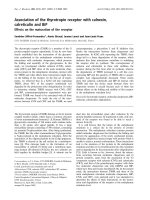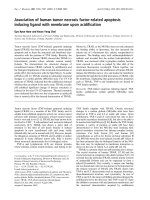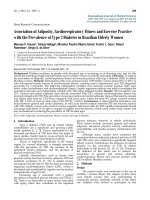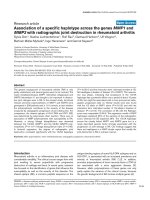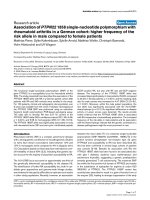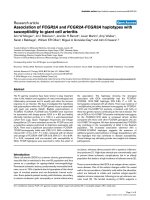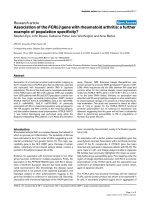Báo cáo y học: " Association of ABO blood groups with Chikungunya virus Short report" doc
Bạn đang xem bản rút gọn của tài liệu. Xem và tải ngay bản đầy đủ của tài liệu tại đây (927.38 KB, 6 trang )
Kumar et al. Virology Journal 2010, 7:140
/>Open Access
SHORT REPORT
© 2010 Kumar et al; licensee BioMed Central Ltd. This is an Open Access article distributed under the terms of the Creative Commons
Attribution License ( which permits unrestricted use, distribution, and reproduction in
any medium, provided the original work is properly cited.
Short report
Association of ABO blood groups with
Chikungunya virus
Naresh CVM Kumar
1
, Mahathi Nadimpalli
1
, Vishnu R Vardhan
2
and Sai DVR Gopal*
1
Abstract
Chikungunya virus (CHIKV) an emerging arboviral infection of public health concern belongs to the genus Alphavirus,
family Togaviridae. Blood group antigens are generally known to act as receptors for various etiological agents. The
studies defining the relationship between blood groups and CHIKV is limited and hence it is necessary to study these
parameters in detail. In the present study 1500 subjects were enrolled and demographic data (Age, Gender, Blood
group, CHIKV infection status, and CHIKV infection confirmation mode) was collected from them. The risk of acquiring
CHIKV disease and its association with factors such as blood group, age and gender was analyzed statistically. The data
of this study showed a possible association between blood group, age and gender of the study population with CHIKV
infection. It is observed that CHIKV infections were higher in individuals with Rh positive blood group when compared
to their Rh negative counterparts.CHIKV infections were found to be higher in Rh positive individuals of AB and A blood
groups than that of Rh negative counterparts. Results also indicated that infections were higher in adults belonging to
the age group > 30 years and also higher in males as compared to females enrolled in this study. These data present
further evidence for the association of the blood groups, age and gender to susceptibility to CHIKV infection. Further
studies are needed to confirm these findings. This is the second study showing the possible association of blood
groups with chikungunya.
Findings
Chikungunya virus (CHIKV), belonging to the genus
Alphavirus, family Togaviridae is transmitted by Aedes
mosquitoes (Ae. aegyptii and Ae. albopictus). Ae. albopic-
tus played a pivotal role in transmitting the CHIKV in the
recent outbreaks of Reunion islands, North Eastern Italy
and India [1-3]. The disease is usually characterized by
fever, arthralgia and myalgia. It was first reported from
Makonde plateau, Tanzania during 1952-53 and since
then, has been held responsible for explosive epidemics in
Africa, India and South East Asia [4,5]. CHIKV, an envel-
oped virus containing positive sense single stranded RNA
as its genetic material is about 11,805 nucleotides in
length containing ORF1 and ORF2 of about 7422 and
3744 nucleotides in length respectively. Phylogenetic
analysis based on partial E1 gene sequences showed the
presence of three distinct CHIKV phylogroups. The first
phylogroup contained all isolates from West Africa; the
second phylogroup involved isolates from East, Central
and South Africa (ECSA); and the third phylogroup con-
tained Asian isolates. CHIKV one of the six major vector
borne diseases endemic to India has reemerged causing
severe mortality during the recent outbreak [6]. It has
been declared as a high priority pathogen by NIH [7]. It
affected 216 districts in India with an estimated 1.38 mil-
lion people as its victims by the end of 2006 and which
further declined to an estimated 59,535, 95,091 and
68,245 cases by the end of 2007, 2008 and 2009, respec-
tively [8,9]. Andhra Pradesh, the most affected state was
first to report the CHIKV epidemic in December 2005 in
India [10]. RT-LAMP assay is a valuable tool used for
rapid, real-time detection as well as quantification of
CHIKV acute phase samples and will serve as an impor-
tant tool for CHIKV surveillance in developing countries
[11]. The association of diseases with blood groups has
always been under controversial discussion. The relation-
ship of blood groups of population and their susceptibil-
ity to diseases like plague, small pox, malaria, cholera etc
suggest the possible role of blood group antigen in the
occurrence of diseases. During the past twenty years
there are many reports documenting the role of blood
group antigens as receptors for parasites, bacteria and
* Correspondence:
1
Department of Virology, College of Sciences, Sri Venkateswara University,
Tirupati 517502, India
Full list of author information is available at the end of the article
Kumar et al. Virology Journal 2010, 7:140
/>Page 2 of 6
viruses [12]. Association of blood groups with HBV infec-
tion and fibrosis severity in HCV infection has been
reported earlier [13]. The studies defining the relation-
ship between blood groups and CHIKV is limited and
hence it is necessary to study these parameters in detail.
Keeping this in view the present study was designed to
determine the relationship between CHIKV infection and
ABO/Rhesus blood groups, age and gender.
During January-February 2010, 1500 subjects from Sri
Venkateswara University Campus, Andhra Pradesh, India
were enrolled in the study. A questionnaire was prepared
and demographic data recorded for each patient included
age, gender, blood group, CHIKV infection status (Yes/
No) and CHIKV infection confirmation mode (Self
declared CHIKV cases (SDC)/CHIKV infection con-
firmed by a physician). The importance of the present
study was explained to the patients and oral consent from
all the patients were obtained prior to data collection.
The statistical tools such as, Odds ratio (OR) with 95%
confidence interval (C.I) is presented to know the likeli-
hood of acquiring CHIKV disease with respect to differ-
ent blood groups: O, A, B and AB (Both Rh positive and
Rh Negative individuals) when compared to healthy indi-
viduals. Chi-square test (χ
2
test) statistic was also carried
out to observe the association between the blood groups
and CHIKV infection. A p value < 0.05 was considered to
be statistically significant.
Among 1500 subjects enrolled in the study, 860 (57.3%)
were males and 640 (42.7%) were females. Among them
513(34.2%) reported to have acquired CHIKV infection
and 987(65.8%) individuals reported absence of CHIKV
fever. Among these 513 individuals 409 (79.7%) patients
were previously confirmed of CHIKV infection by Medi-
cal Officer, S.V.University Health Center by RT-PCR/IgM
strip analysis carried out at Viral diagnostic Laboratory,
Department of Virology, S.V.University, Tirupati as
described by us earlier [14]. The remaining 104 (20.27%)
individuals self declared to have acquired CHIKV infec-
tion (SDC) according to the CHIKV suspected case defi-
nition by NICD, New Delhi [15]. Based on blood group
antigens the individuals were kept in four groups A (324),
B (483), AB (162) and O (531). Figure 1 depicts the repre-
sentation between various blood groups and CHIKV dis-
ease of the present study. The cross tabulation between
the Rh positive and Rh Negative subjects of different
blood groups were associated with the CHIKV status
(Table 1). χ
2
test results showed the statistical significance
at p < 0.05, which suggests that there exists an association
between the blood groups and the risk of acquiring
CHIKV. The Odds ratio is one of the familiar statistical
measures used to know the likelihood of possessing the
risk of acquiring CHIKV disease. The same measure is
used here to know the likelihood of acquiring CHIKV dis-
ease between Rh positive and Rh negative individuals.
The likelihood of acquiring CHIKV disease by O positive
subjects was 2.2 times more than O negative individuals
ie., OR
O
= 2.210 (95% C.I: 1.363, 3.585). The likelihood of
acquiring CHIKV disease by A positive subjects is 2.8
times more than A negative subjects i.e. OR
A
= 2.825
(95% C.I: 1.666, 4.792). In the same manner the likelihood
of acquiring CHIKV disease by B positive and AB positive
subjects is 1.7 & 3 times more than B negative and AB
negative subjects OR
B
= 1.774 (95% C.I: 1.094, 2.876) and
OR
AB
= 3.033 (95% C.I: 1.454, 6.329)respectively. It is also
observed that in A and AB blood groups, though the Rh
positive and Rh negative subjects are almost proportion-
ate in number, but the likelihood of acquiring CHIKV dis-
ease is more to Rh positive subjects. The association is
observed statistically between blood groups and status of
CHIKV focusing on the 'age' factor (Table 2). χ
2
test
results showed statistically significant differences at p <
0.05. The status of CHIKV across the age distribution is
presented for all the blood groups (Figure 2). The individ-
uals > 30 age group are found to be more susceptible in
acquiring CHIKV disease. It is also observed that the
association between gender and the status of CHIKV is
statistically significant (χ
2
= 5.926, p < 0.05) and the Odds
Ratio
Male/Female
= 1.306 (95% C.I: 1.053, 1.619). Therefore
male individuals are 1.3 times more susceptible in acquir-
ing CHIKV disease when compared to their female coun-
terparts.
In conclusion our results implicate that blood group,
age and gender are found to be associated with the status
of CHIKV. It is observed that the Rh positive individuals
are more susceptible when compared to their Rh negative
counterparts in acquiring CHIKV disease. Using odds
ratio (OR), the differences can be observed in between
the Rh positive individuals and Rh negative individuals of
AB and A blood groups followed by O and B blood
groups, where the Rh positive individuals are likely to
have more chance of acquiring CHIKV disease than that
of Rh negative individuals. The interpretation on risk of
acquiring CHIKV disease is given based on the OR value
of each blood group with respect to their Rh positive and
Rh negative blood groups. However, these results do not
comply with the previously reported results where O pos-
itive individuals were shown to be more susceptible in
acquiring CHIKV disease [16]. The difference in the asso-
ciation of the blood groups and CHIKV infection of the
present study to that of the previously documented
report emphasizes the necessity of carrying out similar
studies at multicentre level in order to generate more
data. With increase in age (>30), the chances of acquiring
CHIKV disease are more. Movement of people outdoors
during day time when the activity of Ae.albopictus is at its
peak, lesser personal protection (towards mosquitoes)
and individual's differential immune response to diseases
Kumar et al. Virology Journal 2010, 7:140
/>Page 3 of 6
Figure 1 Representation between various blood groups and CHIKV disease of the present study.
Table 1: Cross tabulation between the Rh positive and Rh Negative subjects of different blood groups with the CHIKV status
Blood group Status of Chikungunya Total Chi-square, Odds Ratio
ABSENCE PRESENCE p-value (95% C.I)
O +VE 320 131 451 10.664, 2.210
O -VE 42 38 80 p = 0.001* (1.363, 3.585)
Total 362 (68.17%) 169 (31.83%) 531 (100%)
A +VE 178 70 248 15.452, 2.825
A -VE 36 40 76 p = 0.000* (1.666, 4.792)
Total 214 (66.05%) 110 (33.95%) 324 (100%)
B +VE 274 127 401 5.493, 1.774
B -VE 45 37 82 p = 0.019* (1.094, 2.876)
Total 319 (66.05%) 164 (33.95%) 483 (100%)
AB +VE 77 44 121 9.132, 3.033
AB -VE 15 26 41 p = 0.003* (1.454, 6.329)
Total 92 (56.79%) 70 (43.20%) 162 (100%)
'*' represents significance at 0.05 level; CI, Confidence Interval
Kumar et al. Virology Journal 2010, 7:140
/>Page 4 of 6
are some of the speculative reasons for increased suscep-
tibility to CHIKV infection in higher age groups (> 30
years)[1,17]. In the present study higher CHIKV infection
rates were observed in males compared to their female
counterparts, an observation which was also evidenced
earlier in North eastern Italy and Southern India and dif-
ferential exposure to Ae.albopictus mosquitoes is sup-
posed to be the plausible reason [1,18]. To the best of our
knowledge, our study is the second report analyzing the
possibility of an association of blood groups with CHIKV
seropositivity. Identification of human cell surface recep-
tor(s) for CHIKV is quite necessary for further under-
standing its pathophysiology in humans [19].Molecular
and functional studies will necessarily be helpful in dis-
closing the association of blood group antigens and
CHIKV infections. The role of blood group antigens as
important key factors in disease development is evident
from earlier studies [12] and hence their possible role on
CHIKV susceptibility cannot be ruled out and needs fur-
ther investigation.
Table 2: Association between age group and CHIKV status
Blood Group Age group Status of Chikungunya Total
ABSENCE PRESENCE
O5-30482270
Chi-square = 12.802* 30-55 32 26 58
p = 0.002 55-80 12 22 34
Total 92 (56.8%) 70 (43.2%) 162 (100.0%)
A 5-30 219 80 299
Chi-square = 25.631* 30-55 74 57 131
p = 0.000 55-80 26 27 53
Total 319 (66.0%) 164 (34.0%) 483 (100%)
B 5-30 149 46 195
Chi-square = 19.066* 30-55 49 41 90
p = 0.000 55-80 16 23 39
Total 214 (66.0%) 110 (34.0%) 324 (100%)
AB 5-30 276 104 380
Chi-square = 10.424* 30-55 64 45 109
p = 0.005 55-80 22 20 42
Total 362 (68.2%) 169 (31.8%) 531 (100%)
'*' represents significance at 0.05 level
Kumar et al. Virology Journal 2010, 7:140
/>Page 5 of 6
Competing interests
The authors declare that they have no competing interests.
Authors' contributions
CVMNK designed and performed the experiment. CVMNK also performed sta-
tistical analysis, interpreted the statistical data and drafted the manuscript. NM
performed the experiment and contributed in writing the manuscript. RVV has
done the statistical analysis and interpretation of the results. DVRSG partici-
pated in the design and coordination of the study, analysis of the data and
drafting of the manuscript. All authors read and approved the final manuscript.
Acknowledgements
CVMNK and NM greatly acknowledge, University Grants Commission, New
Delhi for financial assistance in the form of UGC-JRF in Research Fellowship in
Sciences for Meritorious Students Scheme (RFSMS). The research work of RVV is
supported by DST-CMS project Lr. No.SR/S4/MS:516/07, Dt.21-04-2008.
Author Details
1
Department of Virology, College of Sciences, Sri Venkateswara University,
Tirupati 517502, India and
2
C R RAO Advanced Institute of Mathematics,
Statistics and Computer Science (AIMSCS) - DST, University of Hyderabad
Campus, Prof.C.R.Rao Road, Gachibowli, Hyderabad - 500 046, India
References
1. Moro ML, Gagliotti C, Silvi G, Angelini R, Sambri V, Rezza G, Massimiliani E,
Mattivi A, Grilli E, Finarelli AC, Saptaro N, Pierro AM, Seyler T, Macini P:
Chikungunya virus in North-Eastern Italy: A Seroprevalence study. Am
J Trop Med Hyg 2010, 82:508-511.
2. Philip Samuel P, Krishnamoorthi R, Hamzakoya KK, Agarwal CS: Entamo-
epidemiological investigations on Chikungunya outbreak in the
Lakshadweep islands, Indian Ocean. Indian J Med Res 2009, 129:442-445.
3. Santhosh SR, Dash PK, Parida MM, Khan M, Rao PVL: Appearance of E1:
A226V mutant Chikungunya virus in Coastal Karnataka, India during
2008 outbreak. Virology Journal 2009, 6:172. doi: 10.1186/1743-422X-6-
172
4. Edelman R, Tacket CO, Wasserman SS, Bodison SA, Perry JG, Mangiafico JA:
Phase II safety and immunogenicity study of live chikungunya virus
vaccine TSI-GSD-218. Am J Trop Med Hyg 2000, 62:681-685.
5. Powers AM, Logue CH: Changing patterns of chikungunya virus: re-
emergence of a zoonotic arbovirus. J Gen Virol 2007, 88:2363-2377.
Received: 3 May 2010 Accepted: 25 June 2010
Published: 25 June 2010
This artic le is available fro m: http://www.v irologyj.com/co ntent/7/1/140© 2010 Kumar et al; licensee BioMed Central Ltd. This is an Open Access article distributed under the terms of the Creative Commons Attribution License ( which permits unrestricted use, distribution, and reproduction in any medium, provided the original work is properly cited.Virology Journal 2010, 7:140
Figure 2 Representation of association between Age group and CHIK disease.
Kumar et al. Virology Journal 2010, 7:140
/>Page 6 of 6
6. Dhiman RC, Pahwa S, Dhillon GP, Dash AP: Climate change and threat of
vector-borne diseases in India: are we prepared? Parasitol Res 2010,
106:763-73.
7. Labadie K, Larcher T, Joubert C, Mannioui A, Delache B, Brochard P,
Guigand L, Dubreil L, Lebon P, Verrier B, Lamballerie XD, Suhrbier A,
Cherel Y, Grand RL, Roques P: Chikungunya disease in nonhuman
primates involves long-term viral persistence in macrophages. J Clin
invest 2010, 120:894-906.
8. NVBDCP: Epidemiological profile of chikungunya fever in the country.
(prov.). 2009 [ New
Delhi: National Vector Borne Disease Control Programme
9. NVBDCP: Status report on Dengue and Chikungunya as on
31.12.09(Dengue and chikungunya update). 2010 [http://
nvbdcp.gov.in/Doc/Den_Chik_Dec09.pdf]. New Delhi: National Vector
Borne Disease Control Programme
10. Ravi V: Re-emergence of Chikungunya virus in India. Indian J Med
Microbiol 2006, 24:83-84.
11. Parida MM, Santhosh SR, Dash PK, Tripathi NK, Lakshmi V, Mamidi N,
Shrivastva A, Gupta N, Saxena P, Babu JP, Rao PV, Morita K: Rapid and real-
time detection of Chikungunya virus by reverse transcription loop-
mediated isothermal amplification assay. J Clin Microbiol 2007,
45:351-357.
12. Garratty G: Relationship of blood groups to disease: do blood group
antigens have a biological role? Rev Med Inst Mex Seguro Soc 2005,
43(Suppl 1):113-121.
13. Behal R, Jain R, Behal KK, Dhole TN: Variation in the host ABO blood
group may be associated with susceptibility to hepatitis C virus
infection. Epidemiol Infect 2009. doi: 10.1017/S0950268809991117
14. Naresh Kumar CVM, Anthony Johnson AM, Sai Gopal DVR: Molecular
characterization of chikungunya virus from Andhra Pradesh, India and
phylogenetic relationship with Central African isolates. Indian J Med Res
2007, 126:534-540.
15. National Institute of Communicable Disease, New Delhi: Chikungunya
fever. CD Alert 2006, 10:6-8.
16. Lokireddy S, Sarojamma V, Ramakrishna V: Genetic predisposition to
chikungunya- a blood group study in chikungunya affected families.
Virology Journal 2009, 6:77.
17. Staikowsky F, Le Roux K, Schuffenecker I, Laurent P, Grivard P, Develay A,
Michault A: Retrospective survey of Chikungunya disease in Reunion
island hospital staff. Epidemiol Infect 2008, 136:196-206.
18. Lakshmipathy DT, Dhanasekaran D: Molecular epidemiology of
Chikungunya virus in Vellore distrct,Tamilnadu,India in 2006. East Afr J
Public Health 2008, 5:122-125.
19. Solignat S, Gay B, Higgs S, Briant L, Devaux C: Replication cycle of
chikungunya: A re-emerging arbovirus. Virology 2009, 393:183-197.
doi: 10.1186/1743-422X-7-140
Cite this article as: Kumar et al., Association of ABO blood groups with Chi-
kungunya virus Virology Journal 2010, 7:140
